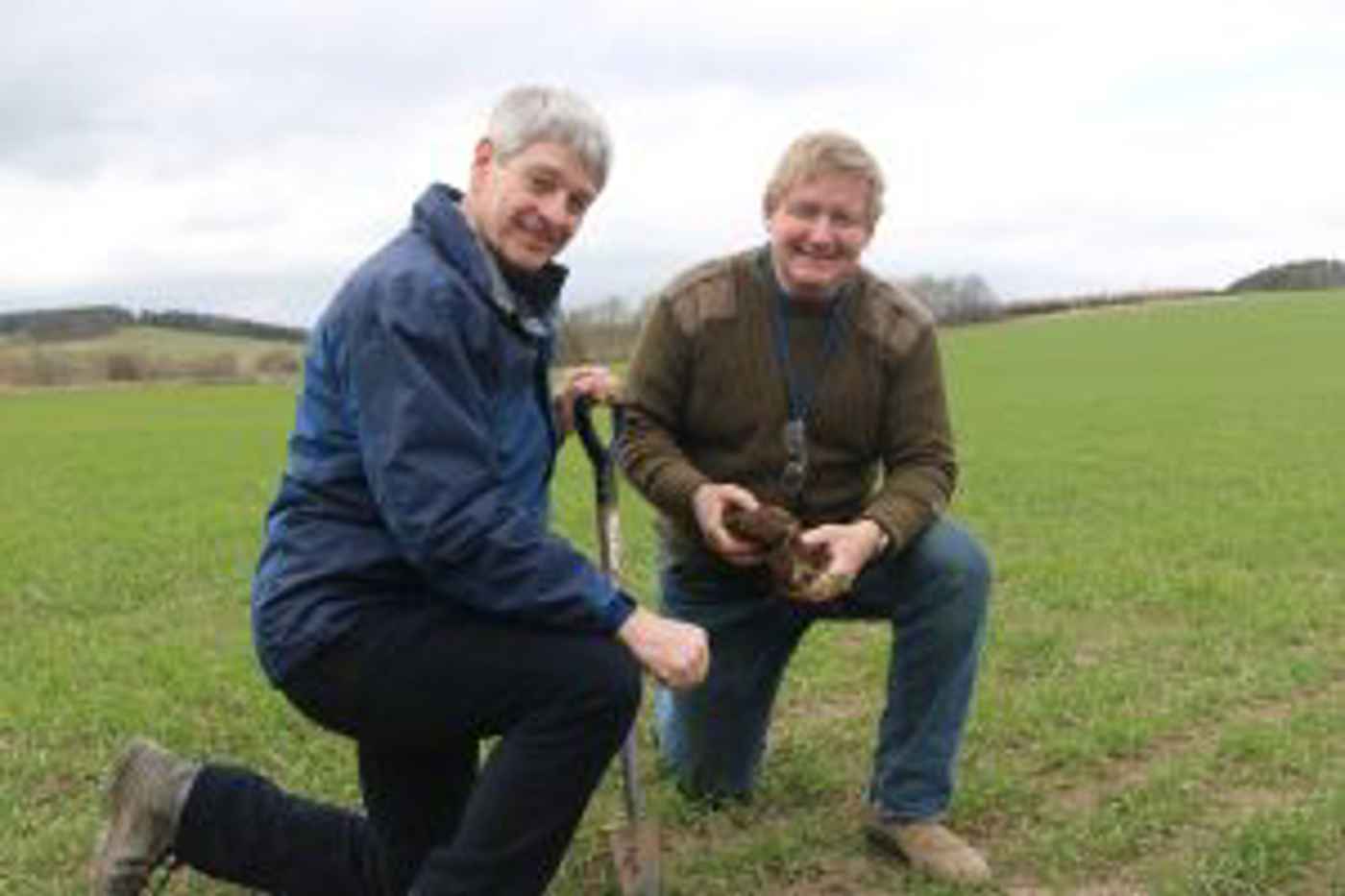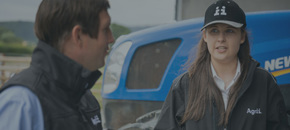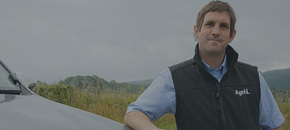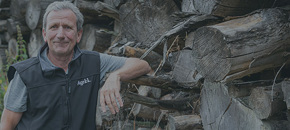
Soil Progress Under the Microscope
Blog - 29.09.22
Northumberland Green Horizons network grower, Tom Fairfax quite literally puts his soils under the microscope to track the progress of the radical switch he’s made to his whole cropping strategy at Mindrum Farm near Cornhill-on-Tweed.
The flagellates moving around and the amoebae he identifies among the soil particles with it are clear evidence that his focus on soil health improvement is paying dividends.
Taking the 465ha mixed light sandy loam farm out of the conventional share-farming agreement it had been in for 20 years, Mr Fairfax is now in his second year of organic conversion.
In a determined effort to ‘listen to’ his soils and be guided by them, he bought a second-hand Moore Unidrill to move the farm away from the plough and power-harrow regime of the past. He still occasionally needs to employ the plough to deal with persistent ryegrass, but minimises its use and always tries to mitigate its impact afterwards.

Manure is worked into compost and held back from spreading for at least a year to increase its humic acid content for the benefit of soil microbes.
A change of direction
“I had something of an epiphany moment five years ago,” he recalls. “But it took me a while to understand what was going on. That year, our winter crops yielded about the same as those we sowed in spring, but the margins was very different.
“We were pushing the crops with a fair amount of artificial N and I felt this was beginning to pull at the fabric of the place. I realise now that I wasn’t paying any attention to what the soils were telling me.
“In a conventional system you focus on the target crop, seeing everything else as a competitor. But if you consider the biological system in its entirety, it’s the diversity that counts and this needs to be carefully managed.
“Nurture this diversity on every level and most of your crop’s nutrition comes from the soil, the sun and the atmosphere; much of which can be unavailable in a conventional system relying on continual input intervention.”
Having decided on a change in direction, Tom Fairfax researched his options thoroughly. His studies of the soil biology literature and Soil Food Web courses stimulated his abiding interest in soil micro-organisms.
“In a fully functioning soil, fungi and bacteria mine nutrients from the soil and the atmosphere, releasing them as they are incorporated into successive layers of the soil food web,” he explains.
“Higher layers in the web have a wider carbon:nitrogen ratio than the bacteria, and release the excess nitrogen and other nutrients, which become available to plants. Added to this, the fungi in the soil effectively use carbon atoms as pit props to strengthen their mycelial networks, which ties up large amounts of excess carbon in healthy soil.
“If all you’re doing is replacing what they do with artificial inputs, you’ll not only make them less active, you’ll lose these valuable microbes altogether.”
A detailed approach to soil biology
With the help of Agrii agronomist, Ruaridh Kohler, Mr Fairfax has made some fairly major changes to the rotation and enterprise mix of the farm in recent years.

“Not everyone wants to make such radical changes, but many of the principles of a soil-led system are the same, whether you’re fully organic, or just looking to embrace a more sustainable approach,” notes Mr Kohler.
“Within Agrii trials we’ve been looking closely at a number of products and management approaches that support or mimic soil biology. Fundamental here is looking in much more detail at the soil and how plants interacts with it. The more we understand this, the more we can apply good science to the way we manage our crops and the products we use.”
“As a Green Horizons network farm, we have been under close scrutiny during our transition,” Mr Fairfax notes. “Ruaridh helps me identify the problems through monitoring, testing or bringing in fresh thinking. We then take a fairly deep-dive approach to soil and plant biology to try and solve them with biology as much as we can.”
In doing this, Mindrum Farms has the advantage of a balance of enterprises, including an 80-head Angus/Shorthorn beef suckler herd and 1000 ewe sheep flock.
The livestock graze 200-240ha of improved and permanent pasture, with a number of low-lying fields that seasonally flood, sensitively managed as part of an agri-environment scheme. The rest of the farm has a blend of arable with grazed or foraged crops in a “diverse integrated system”.
A flexible approach to generating productivity
“We don’t really have a set rotation,” says Mr Fairfax. “Instead, we crop fields according to the needs of the livestock and the progression of the system. We maximise the productive, sustainable balance, both within and outside the cropping season, and try to generate as much productivity as we can from the sun, as storing forage is expensive.
“We aim to harvest all our cereals for grain, but if it looks more suited to forage, we have the option to take a cut of silage.”
One particular field illustrates this approach well. The previous season it was planted with 7.5m strips of Paragon and Mulika wheat, alternating with ryegrass. The ryegrass was cut for silage with the wheat taken to harvest. Then, as soon as the straw was baled, the whole field was grazed hard.
The Mindrum Farm team have now moved on to heritage wheat growing with a living understory of clover. The clover mix was broadcast into the autumn-established wheat in January just ahead of grazing the crop with sheep. This removed any diseased wheat leaves, fertilised the crop and trod in the clover.
The Naroque blend of heritage wheat varieties grown for Wildfarmed Grain in 2021 to a regenerative standard, complemented the organic system. The crop received no artificial inputs, although a little compost tea was applied to stave off what could have become a rust problem.
“The height of the crop has really surprised me,” Mr Fairfax confesses, “It grows to almost six feet tall, and goes almost flat in the wind. But it springs back up again with barely any lodging. We harvested 3.5-4t/ha of grain last year plus a very heavy yield of straw. Interestingly, the long straw also enabled the wheat to outstrip the understory, resulting in a surprisingly clean crop, despite the diverse plant species mix. All good feed for the soil.”
The harvested wheat leaves an established clover-based ley for grazing if there’s enough moisture for regrowth then drilling with a rye cover for grazing in the early spring, either grazing hard again and drilling with a spring crop, or left and cut for silage, depending on the season.
The proof is in the soil...
“The detailed testing of the heritage wheat crop Ruraidh and I undertook was particularly interesting,” Mr Fairfax reports. “The soil samples showed we were deficient in many nutrients, especially nitrogen. Tissue samples came back as in the middle third for most nutrients, and slightly low on N and zinc. But sap testing revealed the crop was in the middle third on everything.
“This really shows the soil biology has reached a level at which it’s mining nutrients and is feeding the crop. If we’d taken the soil test at face value in a conventional system, though, we would have applied N and probably not have benefited from the microbial activity. There is a place for both natural and conventional systems, but we are learning the rules of engagement are different,” he adds.
...and in the cow pats
Stopping by a field where the cattle are grazing – in 1ha blocks with the herd moved on every two days – Tom Fairfax walks over to inspect the condition of a cowpat.
“Pats used to take three weeks to disappear, but we’ve reduced our worming dramatically through faecal egg-counting. So now we have stacks of dung beetles, there’s not much left of them after 5-6 days. That’s another good sign our fertility engine is working above, below and across the soil surface.”
Moving to a field of Laureate spring barley next door, a spade inserted at random brings up plenty of worms and a profuse bundle of roots covered in thick soil, “glued in place” by the glomalin-produced by bacteria.
For most farmers, this would be evidence enough that the system is working. But Tom Fairfax takes a plastic bag and carefully packages up a sample. “This’ll be going under the microscope when I get back, and then we’ll really know what sort of life we have in our soils,” he says.
Join Our Community

Agrii X
We love engaging with clients and partners. Give us a follow and let's share stories for the community.

Agrii Instagram
A picture paints a thousand words. Follow us on Instagram to see what we are up to.

Agrii Facebook
Follow us on the worlds biggest social media site for the latest news and events straight to your feed.

Agrii LinkedIn
If you are all about the business, connect with us on LinkedIn to build your network
Stay In Touch

Newsletter Sign-Up
Receive email updates on topical news and information from around Agrii and UK Farming.

Listen To Our Podcasts
Listen to the Tramlines Podcast. Fortnightly chat about agriculture and trials with your host Tony Smith.

Agrii Insights
Read essential agri intelligence for profitable farming.

Find an Event
Join us for our upcoming events and tours.



